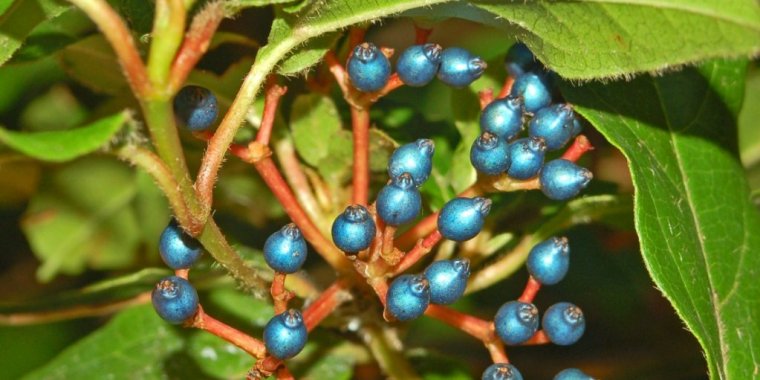| Health / Health News |
Metallic blue fruits use fat to produce colour and signal a treat for birds
The plant, Viburnum tinus, is an evergreen shrub widespread across the UK and the rest of Europe, which produces metallic blue fruits that are rich in fat. The combination of bright blue colour and high nutritional content make these fruits an irresistible treat for birds, likely increasing the spread of their seeds and contributing to the plant’s success.
The researchers, led by the University of Cambridge, used electron microscopy to study the structure of these blue fruits. While there are other types of structural colour in nature – such as in peacock feathers and butterfly wings – this is the first time that such a structure has been found to incorporate fats, or lipids.
“Viburnum tinus plants can be found in gardens and along the streets all over the UK and throughout much of Europe — most of us have seen them, even if we don’t realise how unusual the colour of the fruits is,” said co-first author Rox Middleton.
Most colours in nature are due to pigments. However, some of the brightest and most colourful materials in nature – such as peacock feathers, butterfly wings and opals – get their colour not from pigments, but from their internal structure alone, a phenomenon known as structural colour.
Depending on how these structures are arranged and how ordered they are, they can reflect certain colours, creating colour by the interaction between light and matter.
“The metallic sheen of the Viburnum fruits is highly unusual, so we used electron microscopy to study the structure of the cell wall,” said co-first author Miranda Sinnott-Armstrong from Yale University. “We found a structure unlike anything we’d ever seen before: layer after layer of small lipid droplets.”
The lipid structures are incorporated into the cell wall of the outer skin, or epicarp, of the fruits.
In addition, a layer of dark red anthocyanin pigments lies underneath the complex structure, and any light that is not reflected by the lipid structure is absorbed by the dark red pigment beneath. This prevents any backscattering of light, making the fruits appear even more blue.
The researchers also used computer simulations to show that this type of structure can produce exactly the type of blue colour seen in the fruit of Viburnum. Structural colour is common in certain animals, especially birds, beetles, and butterflies, but only a handful of plant species have been found to have structurally coloured fruits.
While most fruits have low fat content, some – such as avocadoes, coconuts and olives – do contain lipids, providing an important, energy-dense food source for animals. This is not a direct benefit to the plant, but it can increase seed dispersal by attracting birds.
The colour of the Viburnum tinus fruits may also serve as a signal of its nutritional content: a bird could look at a fruit and know whether it is rich in fat or in carbohydrates based on whether or not it is blue. In other words, the blue colour may serve as an ‘honest signal’ because the lipids produce both the signal (the colour) and the reward (the nutrition).
“Honest signals are rare in fruits as far as we know,” said Sinnott-Armstrong. “If the structural colour of Viburnum tinus fruits are in fact honest signals, it would be a really neat example where colour and nutrition come at least in part from the same source: lipids embedded in the cell wall. We’ve never seen anything like that before, and it will be interesting to see whether other structurally coloured fruits have similar nanostructures and similar nutritional content.”
One potential application for structural colour is that it removes the need for unusual or damaging chemical pigments – colour can instead be formed out of any material.
“It’s exciting to see that principle in action – in this case the plant uses a potentially nutritious lipid to make a beautiful blue shimmer. It might inspire engineers to make double-use colours of our own,” said Middleton. (University of Cambridge)
YOU MAY ALSO LIKE






